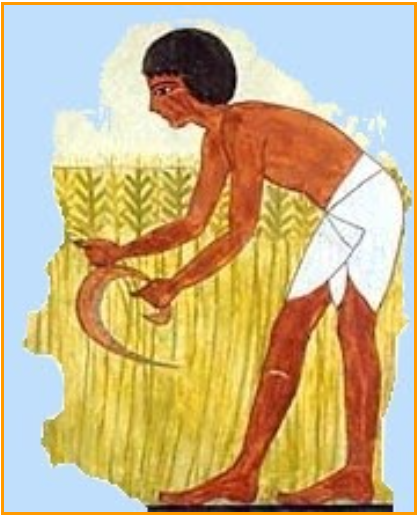
Uncovering Egypt
by Ava-Ray Pributsky
You may think that most of Ancient Egypt has already been discovered and that there is not much new to find. However, that is not the case. Even as recently as the last couple of years, there have been multiple discoveries of vast new burial sites in the region of Saqqara, located in Giza Governorate, Egypt. In November of 2020, archeologists found over 100 wooden sarcophagi, some of them with mummies inside, and over 40 funerary statues. These artifacts were from 2,500 years ago and “in perfect condition of preservation” according to Khaled el-Enany, the Egyptian Minister of tourism and antiquities. Even more recently, in January of 2021, archeologists found 50 more tombs in Saqqara. To share this discovery with the public, Harvard University has created a special virtual tour of one of the excavated tombs.

Archeologists Examining Artifacts at Saqqara
(Link to Tour)
This year, the 6th grade Ancient Civilizations history class at Science Academy has been learning about Ancient Egypt. We first studied the geography of Egypt, how the Nile helped the Egyptian people, culture, and their civilization flourish and survive, as well as how the Nile Valley protected Egyptian civilization from outside forces. Then, we started to learn about the Old Kingdom and the Middle Kingdom, briefly touching upon the Early Dynastic Period. We also learned about the pharaohs who ruled during those periods. Most pharaohs had elaborate, mysterious, and mesmerizing stories behind them, parts of which are still missing and lost in history. We also looked at the Step Pyramid of Djoser, the Great Pyramids of Giza, Hatshepsut’s Temple, and many other important monuments and tombs that were built during the time of Khufu and various other pharaohs. In addition, we delved deeply into the Egyptian pantheon of gods and their rich culture, as well as some of the Egyptians’ advances in mathematics, astronomy, and medicine. Finally, we covered the New Kingdom and its rulers, as well as the sad end to the civilization that was the prime trading center for centuries and the home to one of most beautiful civilizations for over 3,000 years.
As a final project, our class was asked to give an opportunity to work on an Extra Credit project where we wrote an original piece about Egyptian culture as well as an original art piece inspired by Egyptian culture. Here is a gallery of some of the students’ wonderful work.
Hymn to the Nile
by Muaz Reza
All hail to the Nile, the greatest river there is.
Who submerges thyself among the barren lands of Egypt.
Bringing growth to places visibly uninhabitable
Allowing life to sprout and thrive with great joy.
As your water calmly floods our dry lands
It brings pleasure to even the heaviest of frowns
Not a single heart grim, not a single heart sullen.
But brimming with life, awakened for the new season.
Your waters are what allowed us to grow
First a colony, then a kingdom, then finally an empire
We will cherish the gifts that you have provided us
For without them, we would surely cease to exist.
And as we harvest the bountiful crops
Which grow in the fertile lands you have provided
We await once again, your magnificent arrival.
To begin the cycle of life all over again.

Miracles of Ancient Egypt: The Snake-Man and his Master
by Tarisha Hasan
As a farmer, Ahmed worked his fields and tended to the city projects and tombs when the fields were flooded. One day, however, the pharaoh’s only son had died of a mysterious disease. All the citizens panicked, for they knew the pharaoh was aged and nearing the end of his life. As he helped in building the tomb for the prince, he wondered if there was still hope. After the tomb was complete, Ahmed went home to consider the current situation. The late pharaoh’s officials were still trying to find someone.
Ahmed decided that it was finally time to do something. He took to training carefully as a scribe. He hired an artisan to carve a cartouche for the new pharaoh, who was female. The artisan obliged. When the carving was finished, a courier was instructed to deliver the stone carving. However, there was a problem: the weather was bleak and overcast. After a while, it was agreed that the carving should be delivered in a protective covering. When it was finally delivered, however, a lightning bolt struck the herald while he was making his way back.
Back at his mansion, Ahmed was calmly reading a papyrus scroll in his library with his hired artisan when another courier of his came running to his door.
“Master!” Hossain called. Ahmed suddenly turned his head in the direction of the cry. He ran to his other courier as he was certain his prior request would go smoothly.

“What is the matter?” Ahmed was worried. Never before had a close one of his get injured on his watch. The courier said that someone was injured, and they both set
out to save their ally.
By the time they found the first courier, he was in a doctor’s office, lying wounded and exhausted. Hossain asked the doctor how his colleague had become the way he did. The answer was shocking.
“The lightning strike was an omen.”
“What exactly do you mean by this?”
“It’s hard to say. Nevertheless, see that he stays safe. Come back again if he displays any more symptoms.”
Ahmed slowly nodded. He and Hossain carefully carried their ally back home, taking care that they carried him high enough. When they finally got back home, the injured messenger was put to rest.
The next morning, the ill courier began to show signs of severe illness. When he was awakened, it was revealed that the courier’s right hand was growing scales. The same had ha
ppened to his left hand, raising worries. Even after the scales were removed, they kept growing back.
“You’ll have to go to a priest,” the physician said. Even after he tried the spells that they prescribed, they only partially worked. Some of the scales did disappear, but they soon began growing back.
“What shall we do with you, Asaad?” Ahmed asked. “All the cures we tried either don’t work or only work temporarily.” Asaad simply replied, “The reason why there is no permanent cure is that this was destined to happen.” This struck the other two silent for a couple moments. Ahmed then said, “So you knew this was all going to happen?” Assad related his whole story of the particular circumstances he grew up in and how it contributed to his developing lizard-like appearance.
“The only thing you can do right now is let the transformation happen and leave me in peace.” Ahmed realized that there really was no point in trying to find a cure. As a result, he instructed his other herald to make accommodations for Asaad while he went into his chamber to write an entry on his small papyrus journal. A few days later, Asaad was still the same person he was before he became lizard-like. However, word had spread in his town, and people came to inquire after the strange lizard-man he kept as a servant. Ahmed tried his best to keep all the visitors at a distance, but it was no use. Smaller reptilians were not usually common where he lived, let alone hybrids of humans and lizards.
When Ahmed tried to rest after a long day, he found that he was unable to, as he had spent all day fielding requests from his clients to write letters for them. He decided to take a drink that Hossain had offered him, and then after that, he slept rather uneasily through the night. When he woke up, he was more determined than ever to find out the cause of this mutation. He researched for days without stopping, and that’s when he finally found out the cause.
It was revealed that Assad had come from a family of snake charmers outside of Egypt’s borders and that he had caught a rare and incurable disease after a snake bit him. He did survive, but at a great price: he was to become a snake-man. A valuable lesson was learned from this event: no matter how hard one tried, there are times where fate was inevitable and had to take its course.
A Memorable Day in the Life of an Egyptian Farmer
by Mayukh Day

It’s August and the day of the annual flooding of the Nile. This annual flood has been an important natural cycle in Egypt since ancient times. Today is the day where it’s decided how much water Mafas II gets throughout the year.In the morning the farmer, Mafas II, gave a prayer to Osiris, the god of agriculture for lots of water today. Since his wife is pregnant and can give birth at any time, Mafas II, gave a prayer to Bes, the guardian god of childbirth. Next, he ate
his breakfast and set off into the fields, imagining what he would do in the fields today.
In the fields, he first uses the shaduf to irrigate his fields carefully. Then, he puts the stone markings for his boundary of water. After all that hard work, Mafas gathers a few cattle and a few ducks for his meals. Then he returns back to his house for supper.
Then he gives evening prayer to Bes, the guardian god of childbirth, and Osiris, the god of agriculture. For supper he eats meat, bread, and beer. After supper he plays twenty squares and Senet with his son. He stays up late when everyone in the family sleeps.
Then at the dark of night, the farmer paddles nervously out and shifts the stones to steal a few feet of water from his neighbors. Mafas knows this is very profitable, but the penalty of this crime could mean death. Thankfully, no one noticed him do this crime. Mafas goes to bed dreaming of his day tomorrow.
Naunet’s Journey
by Ava-Ray Pributsky
I walk down the dusty dirt path as I head to do some research at The House of Life, to look up medical papyri for how to treat a headache. My patient Abasi, one of many grandchildren of Rameses II, has been complaining of a sharp pain in the back of his head every morning for the past week. Having been trained by my father Djehutyemheb, a wise scribe and physician to the royal family, I am now able to care for royalty. I have given him amulets from the Goddess Isis and the God Heke. Isis is invoked because Abasi is sick and Heka to make the prayer more powerful. I will continue to look for additional cures. It is 1259 B.C.E, and Pharaoh Ramses is in rule. Kemet has just signed a peace treaty with the Hittites, who we have been battling with for several years. I have not known a time when we were not in war with them. Ramses II has spent too much money on fighting, so he decided to make peace with them.

This is the first peace treaty ever for Kemet. I am intercepted on my path by Maat, a young girl servant to Ramses II who has only just started working at the palace Ramesseum. “Naunet, Sese’s daughter Meritamun has a growth in her left eye! She is deeply upset and refuses to go outside for fear of people seeing her.” I try to calm her down and explain to her how I will create a mixture of red ochre that I can get from Abubakar at the temple, green eye-paint of malachite that I can pick up at the House of Life, and honey from the beehive near my house, and I will come to the palace and apply this to the growth two times per day. I also will take some black tea leaves, wrap them in muslin, soak them in hot water, and apply it to the eye. Finally, I will give Meritamun an amulet with the eye of Horus for her to wear. I continue my way down to The House of Life, thinking about the incantations to be prepared.
When the Sun Did Not Rise
by Genessis Gomez
Deep in the underworld there was a serpent called Apophis who detested the sun god Ra. Every night as Ra descended to the underworld for his nightly trip, Apophis was ready with another scheme. That fateful morning was coming, as people started to wake up confused that the sun had not risen. Farmers and merchants walked with lanterns to the places they usually worked confused, thinking that they woke up earlier and that the sun was going to rise very soon. But the priests, who knew about the serpent Apophis, hurried to the temples to help Ra.
The hours started to go by and the farmers, merchants, and even slaves started to worry. As the priests started to gather what they needed and muttered spells from the Book of Dead, the people outside started to pray very loud hoping that Ra was not dead. Back in the underworld, Ra received the prayers and spells (spells were also put on Apophis which was making him weaker). Ra received more power from the human praises above and soon enough he was able to fight off Apophis. He continued to float through the underworld and the sun started to rise again. From that day on, the Egyptians prayed that Ra had a safe passage and never forgot to thank him for the light he gave them every day.
Oh, What Greatness Comes When the Nile Flows
by Ezra Ipsa
Greatness that comes when the Nile flows,
It gives life to Egypt watering fields warmed by Ra,
Allowing our crops to grow so our cattle can live,
And we have food to eat.

Home of the fish, you give us grain and create barley,
Letting us ensure perpetuity to the temples,
And for the gods.
When offerings are made it is thanks to you,
Spreading all through Egypt, the creator of greatness,
You give us water to drink and to give to our livestock.
O, what greatness comes when the Nile flows,
It lets us thrive and prosper,
Like one with the gods we praise you,
For all you have done for us.
A Day In the Life of an Ancient Egyptian Scribe
by Jordin Lin
The sun leaked through the window of the Abasi’s adobe house. He frowned; morning had arrived. Hardly awake, he stood up from his bed and went to take a quick bath. Once finished, he got dressed into more appropriate clothing: a waist-to-knee kilt with a sheer blouse. Abasi was a stern man, as his name did mean ‘stern.’ He was very serious about his role as a scribe. The man absolutely despised it when something got in the way of him doing his job, so he made sure to meticulously plan out his day every morning so that everything would go smoothly. After changing into his outfit, he walked over to his nearby table to eat breakfast. The breakfast he usually ate was simple: lentils, bread, and eggs; it was enough to keep him going until the next meal.
Once he finished with his breakfast, he took out a small piece of papyrus, a thin, reed brush, and some ink. He slowly wrote down a detailed plan of how his day was going, starting from when he finished his breakfast. The main, and only, event on his schedule was to go down to the village and write down what was happening, specifically about the workers as did their labor. After 10 minutes of a walk in the hot sun, Abasi arrived at the nearby village. He looked around and took out his plan for the day. First, he would watch the over farmers, then the carpenter, then the washerman, then lastly, the maker of pots. Placing the note back into his small bag, he readjusted his posture, making sure he looked as presentable as possible

With one last stroke, he was finished for the day. Abasi nodded to the maker of pots, indicating that it was time for him to leave. The pot-maker nodded back at Abasi as he started to place up his papyrus, ink, and reed brush back into his small bag. Once Abasi completed packing up his materials, he exited the workshop. Surprised, he noticed that the sky was already quite dark. He had not noticed how much time had flown by. Quickening his pace, he speed-walked back to his house, ready to eat dinner and go to sleep. Abasi loved the sense of fulfillment every time he did his job without realizing the passing time. Today was such an example. Hours of work felt like only a few minutes. He lied down into his bed, smiling to himself. Rolling onto his side, he fell asleep, preparing for the next day.
The Horizon of Heaven
by Milan Riley










Resources:
Egypt Unearths New Mummies Dating Back 2,500 Years – New York Times
50 ancient coffins uncovered at Egypt’s Saqqara necropolis – The Guardian
Five-thousand-year-old Egyptian tomb opens for virtual tour – The Guardian
Tomb of Queen Meresankh III – Harvard University




